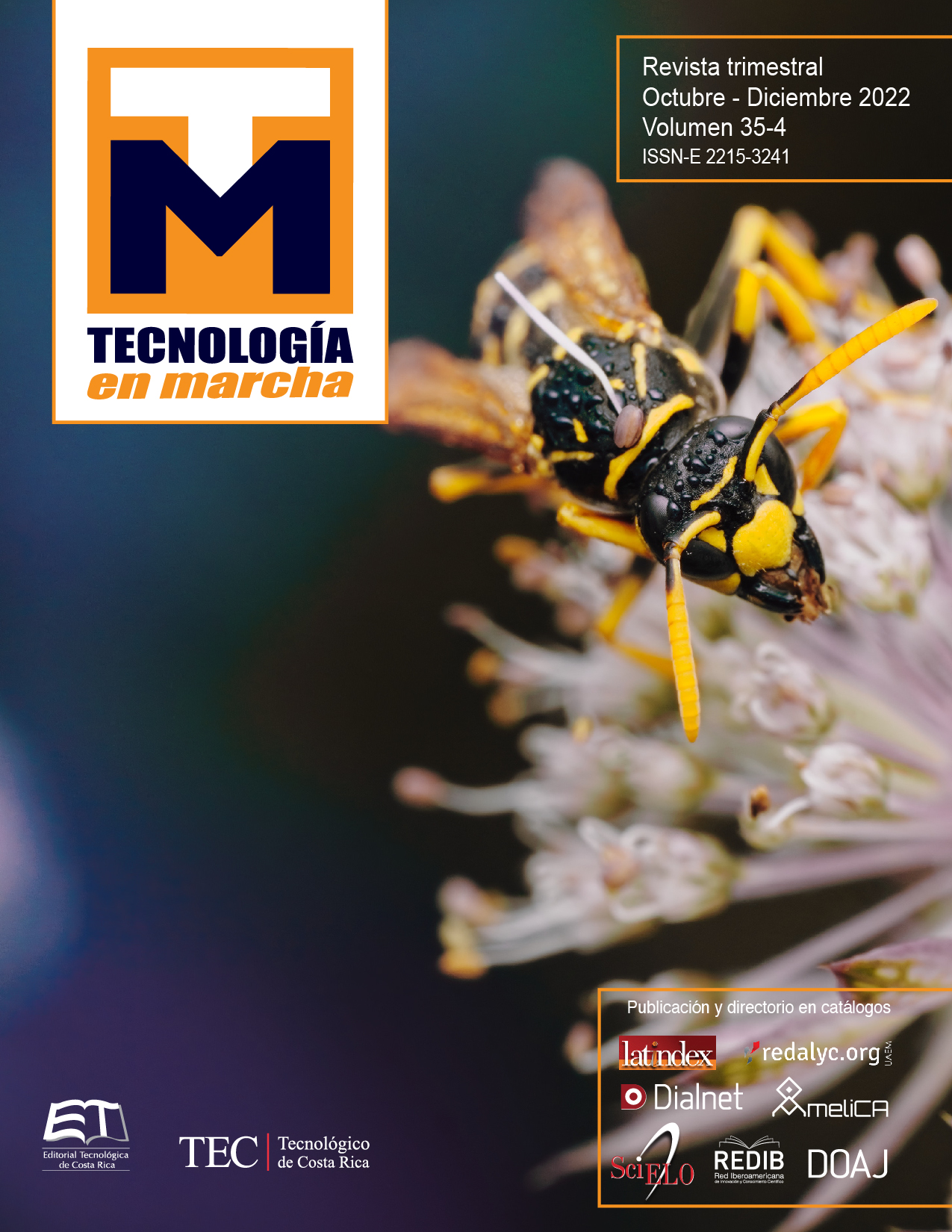Construction hazardous waste in Costa Rica and its environmental impacts
Main Article Content
Abstract
Historically the construction sector has been one of the most important contributors in the economy, since it generates many jobs, thus creating income and progress for the local economy.
However, it causes significant environmental damage as it produces a large amount of waste, some of which are considered hazardous. Despite this, the country does not have an adequate waste management system for those of the construction sector. For this reason, this article has the intention to report on a research done in order to identify the hazardous waste of the construction sector and its environmental impacts. The data were collected through secondary sources, as well as surveys to personnel of construction companies, field visits and focus group consultations. Among the hazardous wastes identified in construction in the country include: acids, solvents, detergents, additives for concrete, oil containers, lubricants, brake fluids, fuels, paint residues and their packaging, concrete release agent, treated wood with chemical compounds, welding residues, silicone and sealants, contaminated soil, utensils containing chemicals and fluorescent tubes. Each of the hazardous waste identified is associated with negative environmental impact in soil, water or air. 100% of them have negative effects on water quality, despite this, it was found that less than 40% of the surveyed companies reuse or recover for recycling these residues and none of them manage adequately all the hazardous waste they generate.
Article Details

This work is licensed under a Creative Commons Attribution-NonCommercial-NoDerivatives 4.0 International License.
Los autores conservan los derechos de autor y ceden a la revista el derecho de la primera publicación y pueda editarlo, reproducirlo, distribuirlo, exhibirlo y comunicarlo en el país y en el extranjero mediante medios impresos y electrónicos. Asimismo, asumen el compromiso sobre cualquier litigio o reclamación relacionada con derechos de propiedad intelectual, exonerando de responsabilidad a la Editorial Tecnológica de Costa Rica. Además, se establece que los autores pueden realizar otros acuerdos contractuales independientes y adicionales para la distribución no exclusiva de la versión del artículo publicado en esta revista (p. ej., incluirlo en un repositorio institucional o publicarlo en un libro) siempre que indiquen claramente que el trabajo se publicó por primera vez en esta revista.
References
Estado de la Nación. (s/f). Estado De La Nación Evolución Y Estado Actual Del Sector Construcción: Impacto En La Economía, 31.
Abarca-Guerrero, L. (2016). Comunicación personal
Mora, G. (2007). Gestión y manejo de desechos de la construcción. 229, 20–21.
UICN. (2011). Guía de manejo de escombros y otros residuos de la construcción, 13–18. Recuperado a partir de http://cmsdata.iucn.org/downloads/guia_escombros_baja.pdf
Leandro-Hernández, A. G. (2008). Manejo de desechos de la construcción. Tecnología en Marcha, 21(4), 60–63.
CYMA, & CEGESTI. (2008). Plan de Residuos Sólidos Costa Rica (PRESOL). Plan de Residuos Sólidos Costa Rica.
Pitchel, J. (2005). Waste management practices: Municipal, hazardous and industrial (Primera). New York.
Abarca-Guerrero, L., & Leandro-Hernandez, A. G. (2016). Guía para el manejo eficiente de materiales de construcción. Cámara Costarricense de la Construcción e Instituto Tecnológico de Costa Rica. Cartago. Recuperado a partir de http://www.construccion.co.cr/descargas/GUIA_MANEJO_MATERIALES_CONSTRUCCION.pdf
EPA. (2004). The Disposal of Soaps and Detergents. Recuperado a partir de http://www.epa.sa.gov.au/files/8431_soaps_detergents.pdf
OPPAC. (2011b). Aguarrás puro, 1–9. Recuperado a partir de http://www.oppac.es/fds/Aguarras.pdf
EPA. (2017d). Ozone Pollution. Recuperado a partir de https://www.epa.gov/ozone-pollution
Kundu, S., Vassanda Coumar, M., Rajendiran, S., Ajay, & Subba Rao, A. (2015). Phosphates from detergents and eutrophication of surface water ecosystem in India. Current Science, 108(7), 1320–1325. Recuperado a partir de http://www.currentscience.ac.in/Volumes/108/07/1320.pdf
Ruckstuhl, S. (2001). Environmental exposure assessment of sulfonated naphthalene formaldehyde condensates and sulfonated naphthalenes applied as concrete superplasticizers. ETH Zürich. https://doi.org/https://doi.org/10.3929/ethz-a-004320247 Rights
Vazquez-Duhalt, R. (1989). Environmental impact of used motor oil. Science of the Total Environment, 79(1), 1–23. https://doi.org/10.1016/0048-9697(89)90049-1
] CORPONOR. (2015). Hoja de seguridad gasolina automotor. Recuperado a partir de http://corponor.gov.co/corponor/sigescor2010/Hojas de Seguridad/HS Gasolina 2015.pd
Ramadass, K., Megharaj, M., Venkateswarlu, K., & Naidu, R. (2015). Ecological implications of motor oil pollution Earthworm survival and soil health. Soil Biology and Biochemistry, 85, 72–81.
H&D Fitzgerald. (2012). Material Safety Data Sheet. Recuperado a partir de https://density.co.uk/wp-content/uploads/2012/02/MSDS-Lube-oils-2012.pdf
Pennzoil. (2008). Pennzoil DOT Super Heavy Duty Breake Fluid. Recuperado a partir de http://www.sfm.state.or.us/cr2k_subdb/MSDS/BRAKE_FLUID.PDF
EPA. (2017e). The Sources and Solutions: Fossil Fuels. Recuperado a partir de https://www.epa.gov/nutrientpollution/sources-and-solutions-fossil-fuels
Dideval. (s/f). XILENO Ficha de Datos de Seguridad. Recuperado a partir de http://ge-iic.com/files/fichas productos/Xileno.pdf
Porwal, T. (2015). PAINT POLLUTION HARMFUL EFFECTS ON. International Journal of Research - Granthaalayah, 3, 0–4.
ATSDR. (s.f). CCA-Treated Wood. Recuperado a partir de https://www.atsdr.cdc.gov/CCA-Treated_Wood_Factsheet.pdf
EPA. (2017b). Burn Wise Best Burn Practices. Recuperado a partir de https://www.epa.gov/burnwise/burn-wise-best-burn-practices
Lenntech. (s/f-b). No Title. Recuperado a partir de http://www.lenntech.com/periodic/elements/index.htm
Dow. (2015). Product Safety Assessment Toluene Diisocyanate. Recuperado a partir de http://msdssearch.dow.com/PublishedLiteratureDOWCOM/dh_096d/0901b8038096dac2.pdf?filepath=productsafety/pdfs/noreg/233-00286.pdf&fromPage=GetDoc
Environmental Pollution Centers. (s/f). Construction sites pollution. Recuperado a partir de https://www.environmentalpollutioncenters.org/construction/
EPA Victoria. (2005). Reducing stormwater pollution a guide for painters. Recuperado a partir de http://www.epa.vic.gov.au/~/media/Publications/981.pdf
Hu, Y., & Cheng, H. (2012). Mercury risk from fl uorescent lamps in China: Current status and future perspective. Environment International, 44, 141–150. https://doi.org/10.1016/j.envint.2012.01.006

